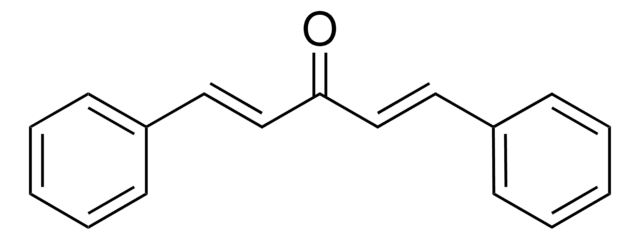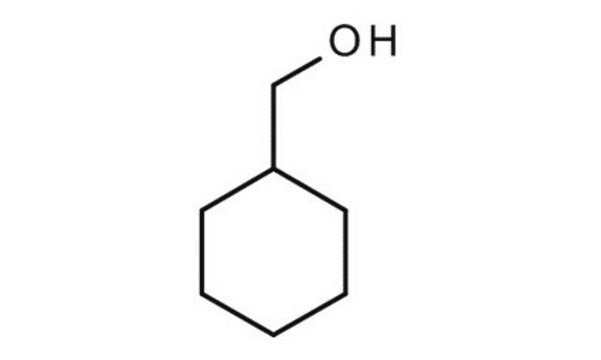Kluczowe dokumenty
09143
Benzaldehyde
analytical standard
Synonim(y):
Bitter almond
About This Item
Polecane produkty
klasa czystości
analytical standard
Poziom jakości
gęstość pary
3.7 (vs air)
ciśnienie pary
4 mmHg ( 45 °C)
Próba
≥99.5% (GC)
Postać
liquid
temp. samozapłonu
374 °F
okres trwałości
limited shelf life, expiry date on the label
granice wybuchowości
1.4 %, 20 °F
metody
HPLC: suitable
gas chromatography (GC): suitable
współczynnik refrakcji
n20/D 1.545 (lit.)
n20/D 1.546
tw
178-179 °C (lit.)
mp
−26 °C (lit.)
gęstość
1.044 g/cm3 at 20 °C (lit.)
Zastosowanie
cleaning products
cosmetics
environmental
flavors and fragrances
food and beverages
personal care
format
neat
ciąg SMILES
O=Cc1ccccc1
InChI
1S/C7H6O/c8-6-7-4-2-1-3-5-7/h1-6H
Klucz InChI
HUMNYLRZRPPJDN-UHFFFAOYSA-N
Szukasz podobnych produktów? Odwiedź Przewodnik dotyczący porównywania produktów
Opis ogólny
Find all available reference materials for compounds listed in 10/2011 here
Zastosowanie
Hasło ostrzegawcze
Danger
Zwroty wskazujące rodzaj zagrożenia
Zwroty wskazujące środki ostrożności
Klasyfikacja zagrożeń
Acute Tox. 4 Inhalation - Acute Tox. 4 Oral - Aquatic Chronic 2 - Eye Irrit. 2 - Repr. 1B - Skin Irrit. 2 - STOT SE 3
Organy docelowe
Respiratory system
Kod klasy składowania
6.1C - Combustible acute toxic Cat.3 / toxic compounds or compounds which causing chronic effects
Klasa zagrożenia wodnego (WGK)
WGK 1
Temperatura zapłonu (°F)
145.4 °F - closed cup
Temperatura zapłonu (°C)
63 °C - closed cup
Środki ochrony indywidualnej
Eyeshields, Faceshields, Gloves, type ABEK (EN14387) respirator filter
Wybierz jedną z najnowszych wersji:
Masz już ten produkt?
Dokumenty związane z niedawno zakupionymi produktami zostały zamieszczone w Bibliotece dokumentów.
Klienci oglądali również te produkty
Protokoły
-Tolualdehyde; Valeraldehyde; Isovaleraldehyde
Nasz zespół naukowców ma doświadczenie we wszystkich obszarach badań, w tym w naukach przyrodniczych, materiałoznawstwie, syntezie chemicznej, chromatografii, analityce i wielu innych dziedzinach.
Skontaktuj się z zespołem ds. pomocy technicznej













